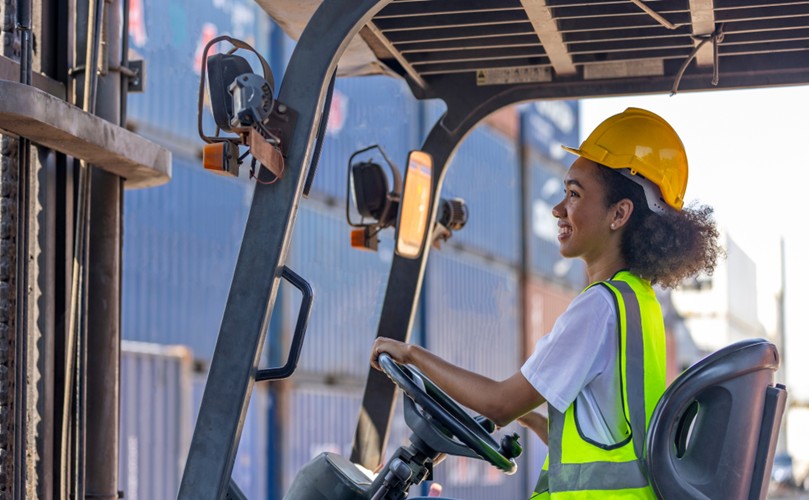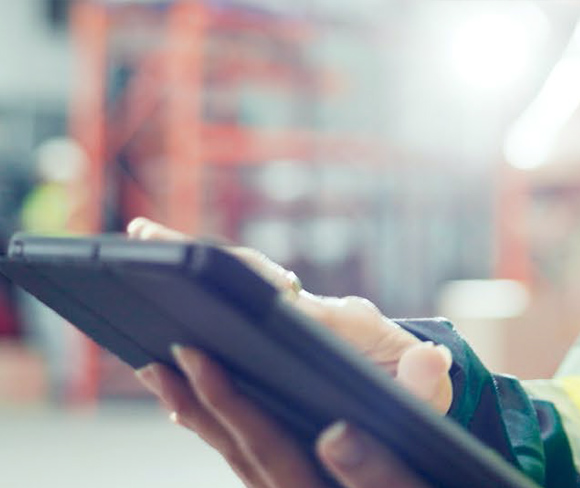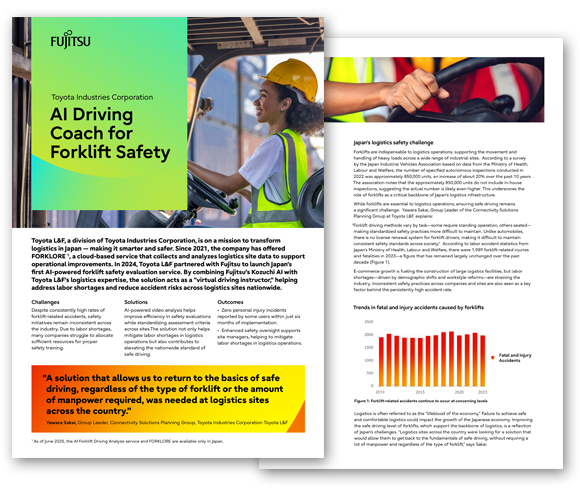Toyota Industries Corporation AI Driving Coach for Forklift Safety

Toyota L&F, a division of Toyota Industries Corporation, is on a mission to transform logistics in Japan — making it smarter and safer. Since 2021, the company has offered FORKLORE*, a cloud-based service that collects and analyzes logistics site data to support operational improvements. In 2024, Toyota L&F partnered with Fujitsu to launch Japan’s first AI-powered forklift safety evaluation service. By combining Fujitsu’s Kozuchi AI with Toyota L&F’s logistics expertise, the solution acts as a “virtual driving instructor,” helping address labor shortages and reduce accident risks across logistics sites nationwide.
Challenges
Despite consistently high rates of forklift-related accidents, safety initiatives remain inconsistent across the industry. Due to labor shortages, many companies struggle to allocate sufficient resources for proper safety training.
Solutions
AI-powered video analysis helps improve efficiency in safety evaluations while standardizing assessment criteria across sites. The solution not only helps mitigate labor shortages in logistics operations but also contributes to elevating the nationwide standard of safe driving.
Outcomes
- Zero personal injury incidents reported by some users within just six months of implementation.
- Enhanced safety oversight supports site managers, helping to mitigate labor shortages in logistics operations.
*As of June 2025, the AI Forklift Driving Analysis service and FORKLORE are available only in Japan.
“A solution that allows us to return to the basics of safe driving, regardless of the type of forklift or the amount of manpower required, was needed at logistics sites across the country.”
Yawara Sakai, Group Leader, Connectivity Solutions Planning Group, Toyota Industries Corporation Toyota L&F

0
Number of personal injury
accidents in the six months
after implementation
- Industry: Manufacturing
- Location: Japan, Kariya City
- People: 77,824 (March 2024)
- Customer's website

About the customer
Toyota Industries Corporation’s Toyota L&F Company is the world’s leading forklift manufacturer in terms of global sales volume. With a rich product lineup and extensive expertise, they comprehensively support customers in “reducing total costs and improving efficiency,” including logistics, management and operations, by providing optimal proposals and execution tailored to their needs.
Forklifts are indispensable to logistics operations, supporting the movement and handling of heavy loads across a wide range of industrial sites. According to a survey by the Japan Industrial Vehicles Association based on data from the Ministry of Health, Labour and Welfare, the number of specified autonomous inspections conducted in 2022 was approximately 850,000 units, an increase of about 20% over the past 10 years. The association notes that the approximately 850,000 units do not include in-house inspections, suggesting the actual number is likely even higher. This underscores the role of forklifts as a critical backbone of Japan’s logistics infrastructure.
While forklifts are essential to logistics operations, ensuring safe driving remains a significant challenge. Yawara Sakai, Group Leader of the Connectivity Solutions Planning Group at Toyota L&F, explains:
“Forklift driving methods vary by task—some require standing operation, others seated—making standardized safety practices more difficult to maintain. Unlike automobiles, there is no license renewal system for forklift drivers, making it difficult to maintain consistent safety standards across society.” According to labor accident statistics from Japan’s Ministry of Health, Labour and Welfare, there were 1,989 forklift-related injuries and fatalities in 2023—a figure that has remained largely unchanged over the past decade.
E-commerce growth is fueling the construction of large logistics facilities, but labor shortages—driven by demographic shifts and workstyle reforms—are straining the industry. Inconsistent safety practices across companies and sites are also seen as a key factor behind the persistently high accident rate.
Trends in fatal and injury accidents caused by forklifts
Logistics is often referred to as the “lifeblood of the economy.” Failure to achieve safe and comfortable logistics could impact the growth of the Japanese economy. Improving the safe driving level of forklifts, which support the backbone of logistics, is a reflection of Japan’s challenges. “Logistics sites across the country were looking for a solution that would allow them to get back to the fundamentals of safe driving, without requiring a lot of manpower and regardless of the type of forklift,” says Sakai.
Balancing ease of use with analytical precision
To address these challenges, a new approach was needed—one that would not disrupt logistics operations or compromise worker productivity. Toyota L&F chose to partner with Fujitsu, a company with deep expertise in AI-powered image analysis.
Together, they developed “Driving Video AI Analysis”, a cloud-based solution that uses AI to evaluate forklift and operator behavior for safety. Fujitsu’s AI service, Fujitsu Kozuchi, is designed to recognize critical forklift behaviors, including turning, movement and safety verification.
The system analyzes dashcam footage in the cloud and automatically detects unsafe actions—such as sharp turns, missed safety gestures, or failure to stop. It also allows users to review only the flagged unsafe moments and provides individual safety performance reports.
The system is optimized to strike a balance between usability and cost, with video frame rates adjusted to minimize data transmission. It also features custom enhancements—such as sub-camera feeds and AR markers—to improve detection accuracy when forklifts move outside the main camera’s view.
Naoya Itatsu, from Toyota L&F’s Connectivity Solutions Planning Group, explains: “Our two main challenges were minimizing the effort required from users to collect video data, and improving the accuracy of the analysis.”
Training AI to accurately interpret forklift operations typically requires a large volume of data. However, logistics sites are complex environments—not only involving forklifts and operators, but also cargo, vehicles, and visual guides such as floor markings.
Recognizing that it would be impractical to account for every possible combination of these variables, Toyota L&F and Fujitsu structured their AI model around approximately 20 core behaviors, including forklift movement, operator actions, and fork operation.
This modular design allows for flexible customization based on customer needs and site conditions, enabling efficient and reliable safety evaluations across a wide range of logistics environments.
AI reveals driving patterns
Forklift-related accidents and near misses don’t always involve strong physical impact, unlike automobile collisions. Identifying unsafe driving behavior has traditionally required careful, manual review of recorded footage by human observers.
Instead of relying on time-consuming manual reviews, AI now helps visualize each operator’s unique driving habits. This not only improves safety awareness but also brings consistency across the team. The solution can be used with any forklift brand, as long as a designated cloud-based dashcam is installed.
In 2021, Toyota L&F launched FORKLORE, a logistics support platform designed to connect various on-site devices to the internet. By collecting, storing, and analyzing operational and usage data in the cloud, FORKLORE has helped customers optimize their logistics operations. The integration of Fujitsu’s AI into the FORKLORE service suite opens new possibilities for enhancing on-site support and addressing broader societal challenges.
Customers asked for a video playback feature that flags specific operational scenes requiring safety guidance,” recalls Naoya Itazu. “We made sure the service wouldn’t add extra burden to on-site teams—this was a key lesson we applied throughout development.” Before launching the new service, Toyota L&F conducted multiple customer trials to validate its practicality and functionality, ensuring that user feedback was fully reflected in the final product.
Building shared safety awareness, with global reach ahead
Since its launch in July 2024, the service has steadily gained traction, with around 15 companies onboard as of March 2025. One customer shared that in a workplace where no one had previously considered pointing and calling during reverse driving, nearly all operators adopted the practice within just three months. Another reported that injury incidents—once occurring several times every six months—dropped to zero after implementation. Across logistics sites, we’re seeing a quiet but meaningful shift: from near misses to real improvements. As one customer put it, “It turned out to be the right choice.”
“We’re currently focused on the Japanese market,” says Mr. Sakai, “but we’re actively sharing insights with our group’s regional headquarters in Europe and the U.S. to explore global opportunities. Frequent staff turnover is a common challenge at logistics sites worldwide. That’s why the company’s ultimate goal is to foster a shared global understanding of safe forklift operation—ensuring consistent safety standards, regardless of who is behind the wheel.
The company is also working to expand the range of behaviors and actions that AI can detect. They continue to expand the AI’s detection capabilities to ensure safety even in complex scenarios. By identifying key challenges, they’re exploring solutions including real-time driving assessments with instant operator feedback.
As a global leader in forklifts, Toyota L&F has actively embraced data utilization alongside product development and sales. Fujitsu supports this effort through “Data Intelligence,” part of its Fujitsu Uvance portfolio, which includes the AI platform Fujitsu Kozuchi.
Combining advanced technology and logistics expertise, Fujitsu and Toyota L&F are shaping a safer, smarter future.
Related Customer stories


Estonian Unemployment Insurance Fund - Modern ERP powers Public Sector efficiency


